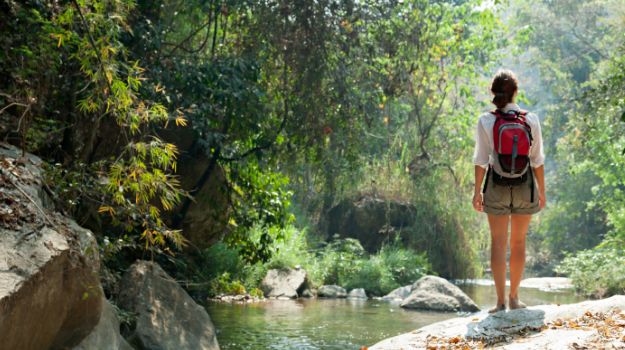Move over, yoga. The new mind-body trend sweeping the nation is the practice of Shinrin-yoku, or simply soaking up the sights, smells, and sounds of nature with the goal of enhancing physiological and psychological health. The term Shinrin-yoku (literally “forest bathing”) comes from Japanese culture, which has a long tradition of living harmoniously with nature.
How does Shinrin-yoku—coined by the Japanese Ministry of Agriculture, Forestry, and Fisheries in 1982—differ from other fitness trends? “A nature walk’s objective is to provide informational content and a hike’s is to reach a destination, but a Shinrin-yoku walk’s objective is to give participants an opportunity to slow down, appreciate things that can only be seen or heard when one is moving slowly, and to take a break from stress,” Ben Page, a certified forest therapy guide who founded Shinrin Yoku Los Angeles, tells the Washington Post.
Shinrin-yoku is considered so effective that it’s covered by insurance in Japan. The proof is in numerous studies including a 2010 study published in Environmental Health and Preventive Medicine. The study, which uses data from field experiments conducted in 24 forests across Japan, found that subjects who took part in forest bathing had lower blood pressure and heart rate. They also had lower concentrations of the stress hormone cortisol than those who walked in a city setting. Another study published in the International Journal of Immunopathology and Pharmacology found that when participants took a three-day/two-night trip to various forest areas in Japan, it seemed to boost their immunity. Blood samples taken before and after the trip showed that the number of white blood cells (which fight off infection and disease) and other immune system markers were significantly higher after forest bathing.

Want to try forest bathing? Here’s how to do it:
1. Leave all your digital devices behind so that you can be fully present in the experience. Don’t be concerned with how many calories you’re burning or how long your hike is.
2. Wander around. Let your curiosity be your guide.
3. Pause from time to time to admire the bark on the tree or a leaf floating downstream.
4. Find a good spot to sit comfortably and listen to the sounds around you. Notice the behavior of birds or squirrels when you sit still and they become used to your presence. Watch the insects travel on the ground. Close your eyes for a few minutes and listen to the peaceful sounds around you.
5. If you’re walking with a friend or group, minimize the chit chat. Wait till the end of the walk to share your observations together.
For obvious reasons, a forest is key to practicing Shinrin-yoku, but if there are no forests nearby, don’t give up the idea. A 2015 Stanford University study found that people who strolled in a serene, natural setting—even a public park—were less anxious than when they walked through the city. Some evidence suggests that even gazing at natural wonders can lower your stress levels. If you’re feeling some tension right now, check out these breathtaking photos of incredible landscapes and feel the stress melt away.








